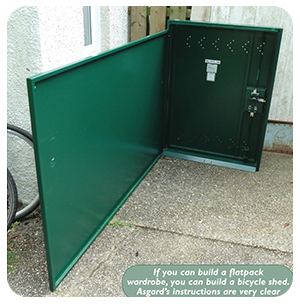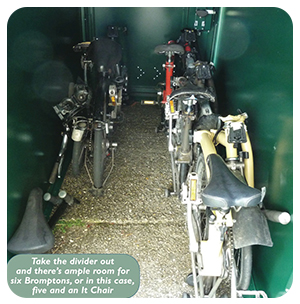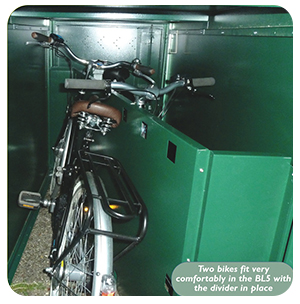Asgard bike lockers can store brompton bikes

AtoB - Tested: Asgard BL5 Bike Locker
Years ago, when we produced The Folder from a sort of undergraduate household full of guitars, maps, empty cider bottles and people passing through in dressing gowns, our bicycled generally lived indoors. To be fair, they were most Bromptons, so space wasn’t the issue it might have been, but one by one the waifs and strays were evicted, the rooms tarted up, and the bicycles put out to graze in the shed.
Not everyone has the space for a shed of course, and in many places a shed just doesn’t provide a secure home for your bicycle. The answer, as an increasing number of people are finding, is a dedicated. Steel. Shed. There are several on the market, and one of the biggest manufacturers is Asgard Secure Steel Storage, which designs and manufacturers a range of steel sheds from its factory in Bradford.
If you can think of a purpose for a steel shed, Asgard probably makes it, from real biggies for motorcycles to small units for gas bottles. The bicycle range covers about eight models, broadly in two groups – end access boxes for one or two bikes, and side – or roof-access boxes for three or four bikes. These sheds cover two. Rather different markets: the top-openers are really. For in-garden use, while the end-openers are more secure and lower profile, and thus better suited to an exposed front garden, where they would expect to be locked as a matter of course.
“…this is the sort of thing you’d see at a railway station or bicycle-friendly business…”
We wanted to try something secure, compact, and suitable both for home or small business use, and settled on the BL5 double-ended two bike locker. This is the sort of thing you’d see at a railway station or in the car park of a bicycle friendly business. It measures two metres long by 0.9 metres wide and 1.2 metres high, with a door at each end secured by an integral lock and three-oint latching system. There’s a divider running diagonally inside to two users can store and retrieve their bikes independently, and the slab-sided units can be bolted together to create a very space efficient modular bike storage block.
The BL5 is the sort of thing you might want to steer your employer towards, because for commercial use, the price tag of £599 per unit is very reasonable. The trick is to campaign for one, then when it gets oversubscribed, work towards the purchase of another, and so on, until your office has become fully bike friendly. This sort of storage is a bit sophisticated and expensive for home use, but it would be ideal in the shared space of a subdivided house or block of flats, where two users might want individual access. As such, it’s a bit unusual, because it bridged the gap between basic cut-price domestic sheds and the more expensive, bullet-proof, commercial designs.
For basic home use, the company also produces the BL4 and BL3. These do not have the three-point integral lock of. The BL5, so users have to bring a padlock, making these units less suitable for commercial or multi-access use, and potentially more vulnerable to break-in. All the stores have simple hooks for hanging your bits and pieces, and they’re important because the concrete floor will get wet unless you can seal it. The doors have neat ventilation slots, which are a bit of an Asgard trademark.
|
|
|
|
Fitting
The first thing you need is a completely level concrete base, measuring a little more than the shed (Asgard recommend 50mm either side, and 100mm at each end, although if you’re not bolting it down you could go a lot closed). We were hoping to demonstrate the Asgard in Teresa’s front garden, because it’s a classic location and she desperately needs a bike store, but the available space is 20cm too narrow… probably a common issue. If it had fitted, bolts would be irrelevant here, because the store would have been squeezed in so tightly between the wall and the house that removal would have been impossible.
The Asgard arrives in flatpack form, and you put it together using an instruction manual, along Ikea lines, but much clearer. The unit arrives on a lorry, and in the case of BL5, it weighs 150kg, with the heaviest bits quite hard for one person to carry, so you don’t want to be carrying it far from the delivery point. The only fully assembled bits are the doors, which are ready to use, complete with hinges, frames and locks. The various parts are all pre-drilled and the instructions are nice and clear, so fixing the units together with self-tapping screws and bolts is very straightforward. We assembled ours in about an house and a half, including quite a lot of time talking to nosy neighbours, because if you put one of these in your garden, everyone will want to know what you’re going to put in it. In a Catch 22 sort of way, this is the downside to the operation, because if you’ve lived for years with a down-at-heel garden shed, you average thief will leave it alone, but if you put Fort Knox in the front garden, they’ll think you might have something worth stealing, even if its he same rus old bike ha previously lived unlocked and on display.
The only time-consuming par is drilling holes with a 6mm masonry drill into your concrete base. Our house was built in 1947, when there was a lot of left-over concrete formulated to keep Hitler’s Panzer divisions at bay. Modern masonry drills are no match for this stuff, so for the purposes of the demonstration, we omitted this stage, but as a rule, drilling a few holes 70mm into concrete should not be too taxing. The anchor bolt threads are self-cutting, so one the holes are drilled, you simply bolt down.
Folders
The BL5 takes two conventional bikes, but we couldn’t resist filling it with Bromptons as a demonstration. With the central divider removed, maximum capacity would be a dozen or so in a bit of a heap, but more realistically six bikes will fit neatly and easily into the BL5, and the double ended design means you’ll never have to remove more than one bike to reach the one you want. You do have to watch your head climbing in and out, which is not a problem pushing conventional bikes in, but in all other respects, this would make a very space-efficient storage system for any size where multiple Bromptons come and go, and security is important.
Conclusion
Assuming you have enough space, which Teresa sadly didn’t, and you want a basic store for one or two bikes, your decision probably comes down. To price. The more basic BL4 single bike unit currently costs £449 including VAT and is actually quite generously proportioned for a single bike, and would take two, and a couple of micro-scooters at a pinch.
At the cheap end, competition is mighty fierce these days. Trimetals makes a side/top opening three bike store, but that’s more of an -in-garden device and probably not as secure as a front-opener. Ironstore makes a single store similar to the BL4 for less than £400, although oddly, the company isn’t taking orders at the moment while factory space is reorganised. A strange thing to do in a recession.
At the other end of the scale, the BL5 is an attractive proposition for light commercial applications, and Asgard finds it’s already being specified by architects keen to include some secure bike space in a shared environment.
These units are quite expensive, but they keep your bike secure (Asgard claims only one has been broken into to date, after the cheap padlock was cut off), and that can mean cheaper insurance, although this does depend on the company.
Original Printed Review
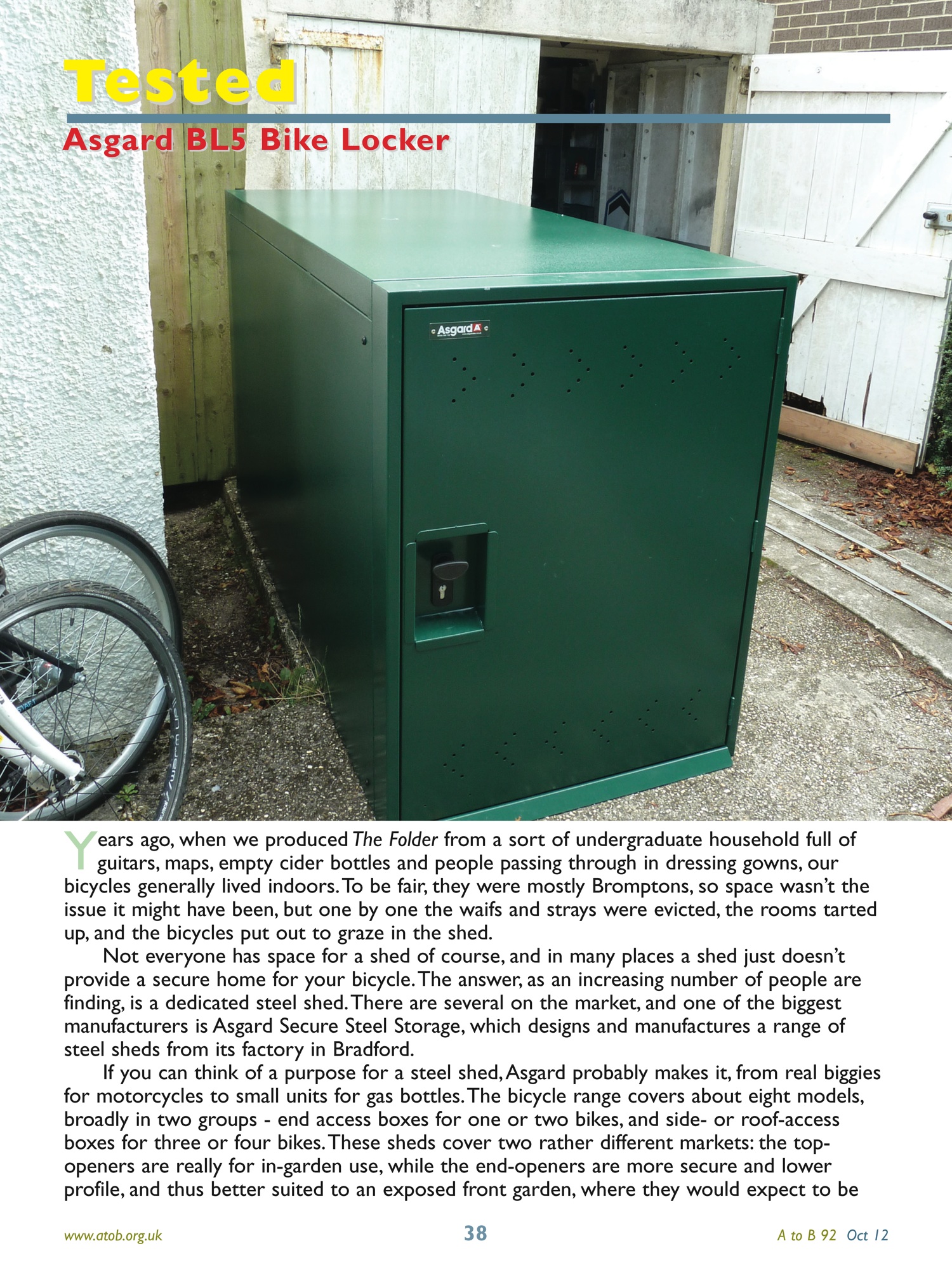 |
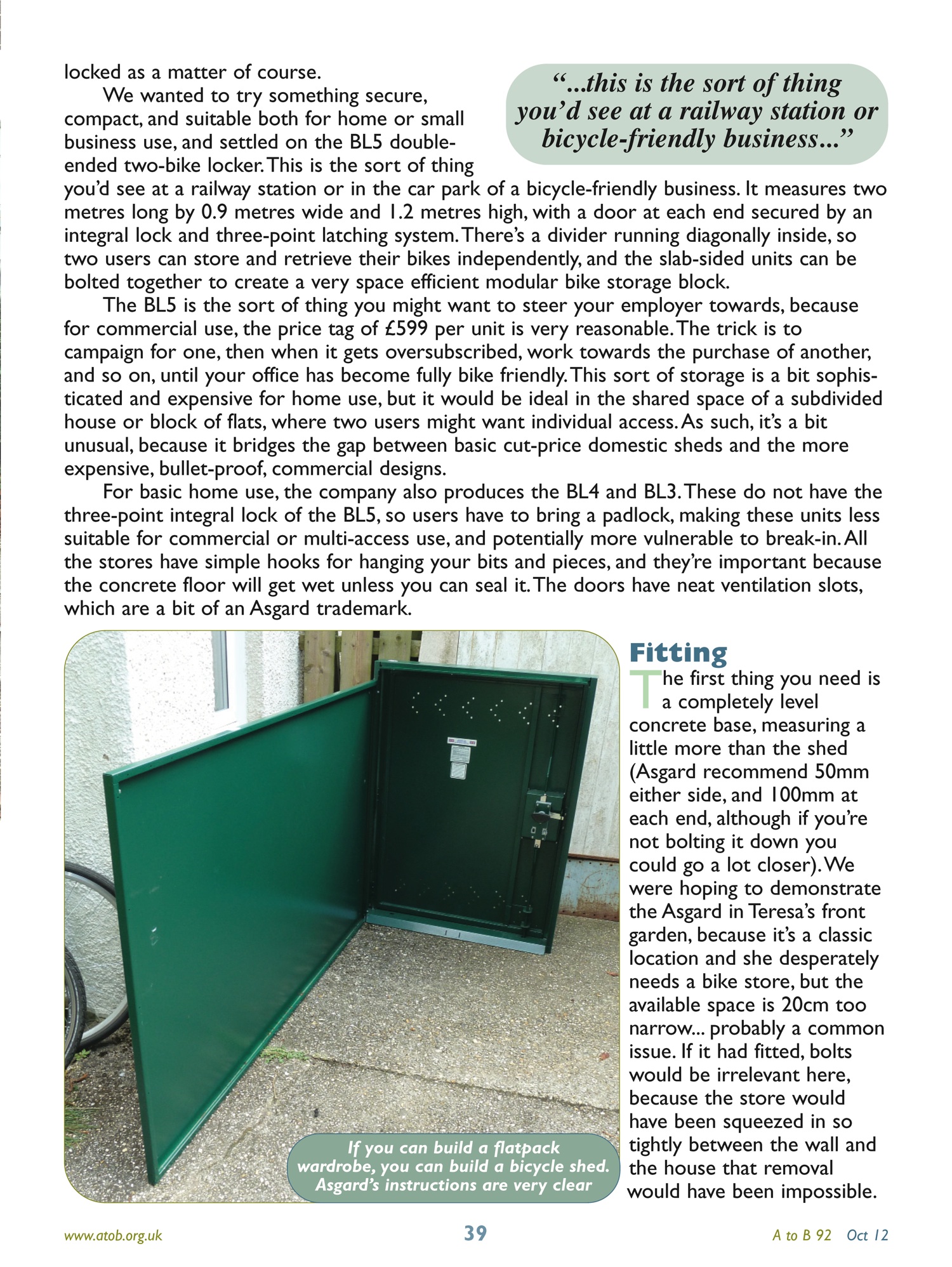 |
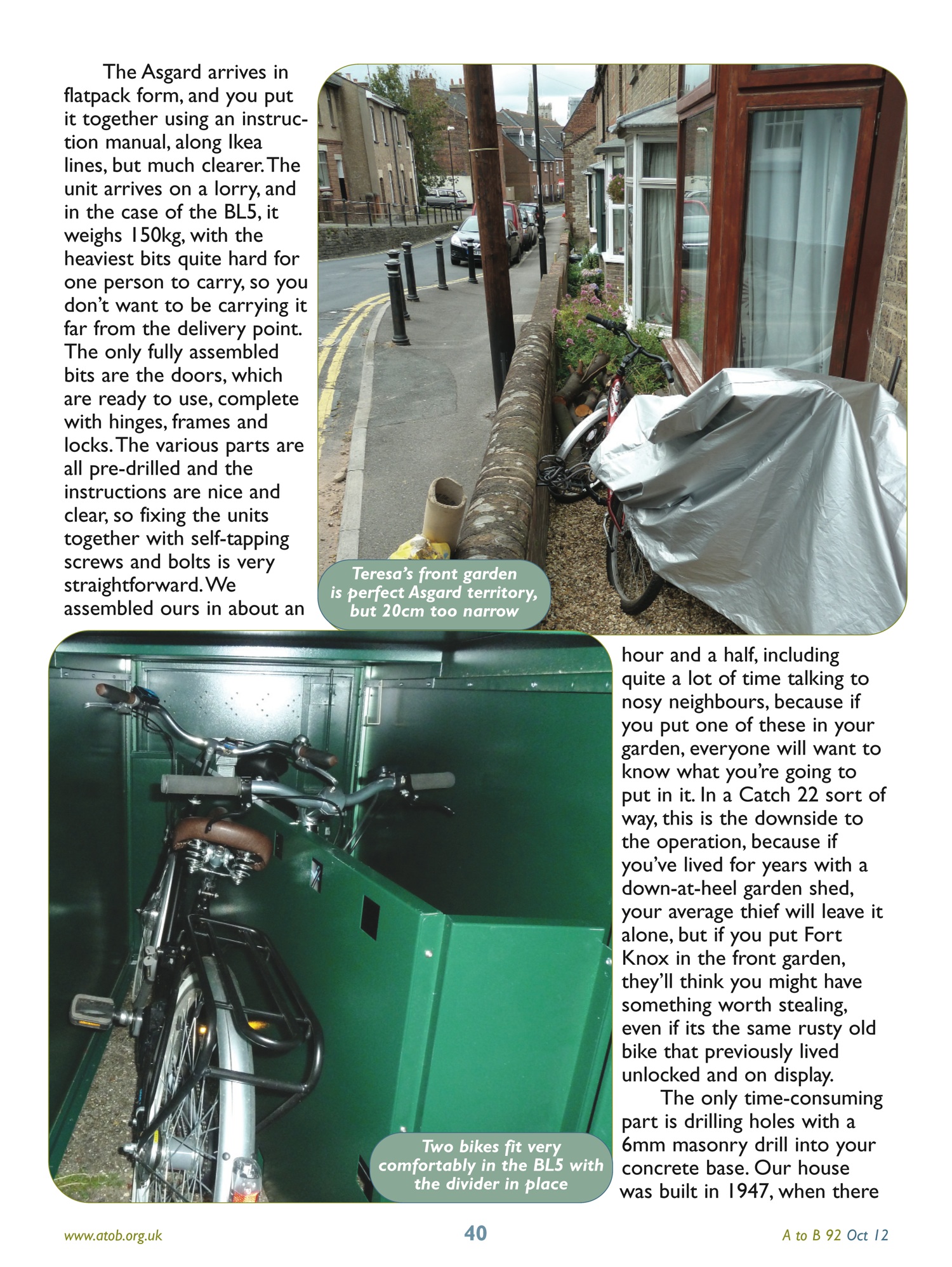 |
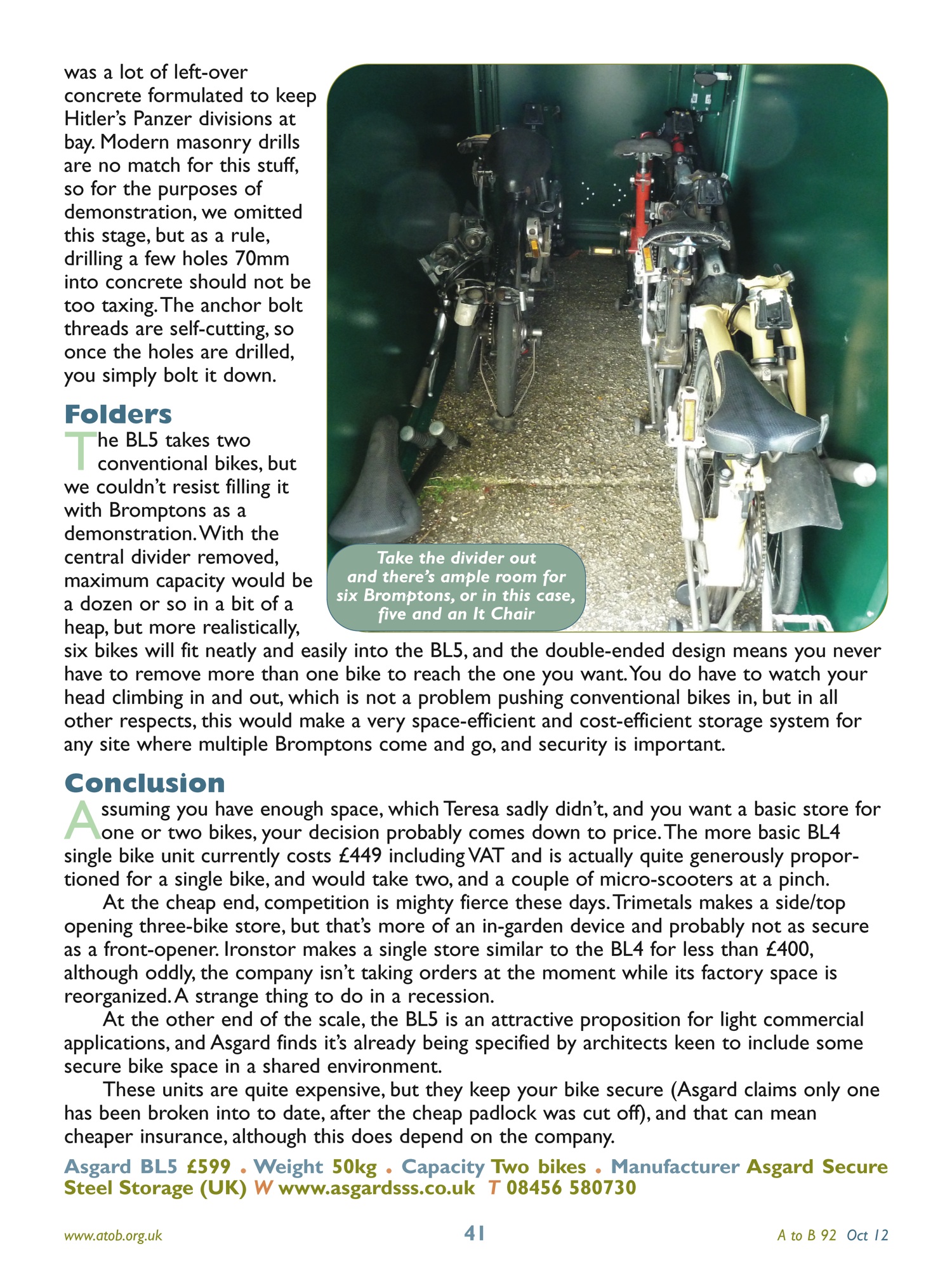 |









